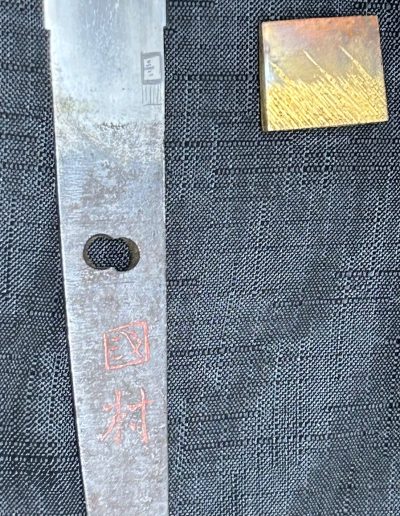Tantō Den Higo, Attributed to Enju Kuniyoshi from Higo Province a red Lacquer Mei by Honami attributing to Kunimura. mounted in newly made Japanese Shirsaya
Blade length ~ 29.1 cm
Mei Signature:shu-mei on the omote side: Kunimura (国村)
shu-mei on the ura side: Honʼa + kaō (本阿「花押」)
Kanmuri-otoshi-zukuri, shin no mune,
Forged in itame with a shirake-utsuri
Hamon is hoso suguha featuring nijūba
Bōshi is a maru-kaeri
Engravings: on both sides a naginata-hi that ends in
marudome above of the machi
Suriage Nakago has 2 mekugi-ana
yasurime are kiri
Made around Tenbun (天⽂, 1532‒1555)
KUNIMURA (国村), 1st gen., Shōwa (正和, 1312-1317), Higo – “Kunimura” (国村), called Enju Tarō (延寿太郎),
son-in-law of Rai Kuniyuki (来国行), he is considered as founder of the Enju school, he was according to tradition the
son of Hiromura (弘村) who is regarded as ancestor of the Enju school, Hiromura had moved from Yamato to
Yamashiro where he became the student and son-in-law of Rai Kuniyuki (来国行), some say that Kunimura even signed
with Rai Kunimura (来国村) during his stay in Yamashiro, towards the end of the Kamakura period, he moved to
Kikuchi (菊池) in Higo province where he founded as mentioned the Enju school that was named after his first name
Enju Tarō, we know blades from the Shōwa to the Kenmu era (建武, 1334-1338), they have a tachi-sugata of the late
Kamakura era with a somewhat elongated ko-kissaki, the jigane is a dense ko-itame with fine ji-nie, a tendency to masame,
and shirake, the hamon is in general a suguha but can also show mixed-in ko-midare and/or ko-ashi, his hamon interpretations
remind of Ryōkai (了戒) and of Rai Kunimitsu (来国光), the tang has an ha-agari kurijiri and kiri or slightly slanting
katte-sagari-yasurime, jō-saku














